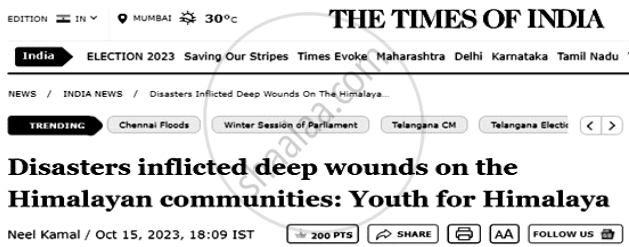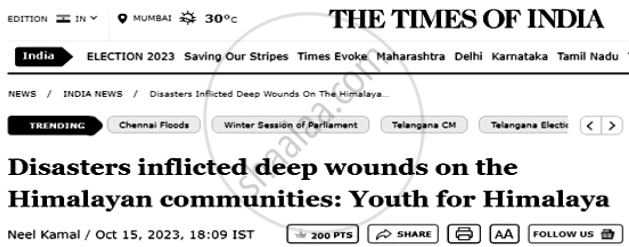Advertisements
Advertisements
Question
Answer the following question:
What is obsessive-compulsive disorder?
Solution 1
Obsessive-Compulsive Disorder (OCD) is an anxiety disorder defined by the occurrence of unwanted and intrusive obsessive thoughts or distressing images; usually accompanied by compulsive behaviors performed to neutralize the obsessive thoughts and images.
Solution 2
Obsessive-Compulsive Disorder:
It is defined by the occurrence of unwanted and intrusive obsessive thoughts that are usually accompanied by compulsive behaviors performed to neutralize the obsessive thought. Criteria for Obsessive Compulsive Disorder (According to DSM-IV-TR).
Obsession is defined by :
- Recurrent and persistent thoughts that are intrusive and cause anxiety.
- Intrusive thoughts come frequently and. trigger extreme anxiety that gets in the way of day-to-day functioning.
- Person attempts to suppress, ignore or neutralize them by some other thought or action.
- Person recognizes thoughts are a product of his/her own mind.
Compulsion is defined as :
- Repetitive behaviors (hand washing, ordering, checking) or mental acts (praying, counting). The person feels driven to perform in response to obsession.
- Behaviors or mental acts aim at preventing or reducing distress.
1. Person recognizes that the obsessions and compulsions are excessive and unreasonable.
2. Obsessions and compulsions cause marked distress and interfere significantly with normal functioning.
Causes:
Biological factors:
(i) Genetic influences:
Evidence from twin studies reveal a moderately high concordance rate for monozygotic twins and a lower concordance rate for dizygotic twins.
(ii) Abnormalities in brain function:
PET scans have shown that people with OCD have abnormalities in the active metabolic levels in the caudate nucleus, the orbital frontal cortex and cingulated cortex.
(iii) The role of serotonin:
Current evidence suggests that increased serotonin activity and sensitivity of some brain structure to serotonin are involved in OCD symptoms.
Psychosocial factors:
(i) Behavioral viewpoint:
According to O.H. Mower’s two-process theory of avoidance learning, neutral stimuli become associated with frightening thoughts or experiences through classical conditioning and elicit anxiety. For example – touching a doorknob or shaking hands might become associated with the ‘scary idea’ of contamination. Once learned such avoidance responses are extremely resistant to extinction.
(ii) Cognitive biases and distortions:
People with OCD seems to have difficulty blocking out negative irrelevant input or distracting information so they may attempt to ‘suppress’ negative thoughts stimulated by this information. Trying to suppress negative thoughts may paradoxically increase their frequency.
OCD is also caused by the faulty belief where a person believes that having a thought about doing something (for instance killing a person) is equivalent to doing it (having killed a person). This is known as thought-action fusion. This belief keeps increasing anxiety due to expectation of causing harmful consequences. This impels the person to engage in various compulsive behaviours to reduce the likelihood of any harmful consequences.
Psychodynamic perspective:
This view suggests that obsessions and compulsions stem from unconscious conflicts arising when primitive Id impulses are conflicting with socially acceptable behaviors. Since the conflict is highly distressing the person may resort to something more manageable, like an intrusive thought or an associated compulsive behaviour.
APPEARS IN
RELATED QUESTIONS
Answer the following question briefly:
What is meant by phobia?
Answer the following question briefly:
Mention any one characteristic of passive-aggressive personality disorder.
Give any two causes of severe depression.
In which type of Behavioural Analysis Test, an Individual is instructed to play a role for which he/she is observed?
Assertion: Some survivors of natural disasters are more prone to anxiety, depression and stress in comparison to other survivors.
Reason: These survivors feel the intensity of loss more than the other and are likely to develop post traunmatic stress disorder.
| Therapist: | “In our last session, you told me that you do not like attending any social gathering.” |
| Simran: | “Yes, I do not like to attend such functions and prefer to be alone.” |
| Therapist: | “Why is it so?" |
| Simran: | “When I was young my uncle made fun of me in front of my cousins. Since then, I shy away from social situation. I am very sensitive to criticism, so I prefer being on my own.” |
- Identify the disorder displayed by Simran.
- Briefly discuss any three cause of the disorder displayed by Simran.
Sumit, aged seven years, is often scolded by his teachers as he distracts his classmates. The teachers have to make extra efforts to make him sit in class and pay attention. He disrupts the class by walking around.
- Identify the type of disorder displayed by Sumit.
- Explain any three symptoms of the disorder identified in subpart (a).
Observe the image given below and answer the question that follow.

Predict any two possible psychological impact that natural disasters can have on the Himalayan community.
Observe the image given below and answer the question that follow.

Enumerate any five ways to promote pro-environmental behaviour among people.
Read the passage given below and answer the questions that follow.
|
Fifteen candidates applied for the position of Executive Manager in a private company. The candidates were called individually for a conversation in the first round of recruitment. In the second round, they were given a list of statements on personality factors that they had to rate a scale value for. The final round consisted of a group task in which the candidates were divided into three groups. Each group had to overcome a problem situation given to them. |
- Describe the types of behavioural analysis that were conducted on the candidates in the first and second rounds. (4)
- In your opinion, which type of behavioural analysis would help the directors select the suitable candidate? Justify your answer by giving two reasons. (3)
